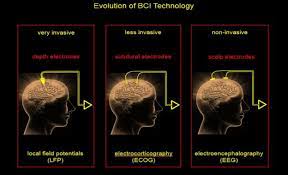Introduction
The evolution of brain-machine interfaces (BMIs) is a testament to the relentless pursuit of merging human intelligence with machine capabilities. From early experiments to cutting-edge neurotechnology, the journey of BMIs reflects a fascinating exploration of the intricate connection between the human brain and advanced machines. This article traces the evolution of BMIs, highlighting key milestones and the transformative impact on various fields.
Early Exploration and Invasive Interfaces
The inception of BMIs dates back to the mid-20th century when researchers began exploring direct connections between the brain and machines. Early experiments involved invasive procedures, implanting electrodes directly into the brain. These pioneering efforts laid the foundation for understanding neural signals and their potential for controlling external devices.
Emergence of Electroencephalography (EEG) Based Interfaces
Advancements in non-invasive techniques led to the emergence of EEG-based BMIs. EEG measures electrical activity on the scalp, allowing for the interpretation of brain signals without invasive procedures. This innovation marked a significant step forward, enabling real-time monitoring of brain activity and paving the way for applications in healthcare and neurofeedback.
Brain-Computer Interface Applications in Medicine
The evolution of BMIs found early applications in the medical field. Paralyzed individuals gained newfound independence through brain-controlled prosthetics. EEG-based interfaces enabled communication for individuals with locked-in syndrome, opening up possibilities for improved quality of life through technology-assisted communication and control.
Neurofeedback and Cognitive Enhancement
As BMIs advanced, researchers explored applications beyond medical contexts. Neurofeedback, a technique using real-time monitoring of brain activity to teach self-regulation, gained popularity. Cognitive enhancement became a focal point, with BMIs designed to improve attention, memory, and overall cognitive function through targeted interventions.
Development of Intracortical Interfaces
Intracortical interfaces represent a leap in BMI technology, allowing for more precise and direct communication with the brain. These interfaces involve implantable devices placed directly on the surface of the brain, providing finer control over neural signals. Intracortical BMIs have shown promise in restoring sensory and motor functions in experimental settings.
Neuralink and the Vision of High-Bandwidth Communication
The evolution of BMIs took a groundbreaking turn with the emergence of companies like Neuralink. Founded by Elon Musk, Neuralink aims to develop high-bandwidth interfaces for direct communication between the brain and external devices. The vision includes addressing neurological conditions, enhancing cognitive abilities, and even enabling symbiotic relationships with artificial intelligence.
Advancements in Signal Processing and Machine Learning
The evolution of BMIs is closely tied to advancements in signal processing and machine learning. Improved algorithms for decoding and interpreting neural signals enhance the accuracy and efficiency of BMI applications. Machine learning algorithms allow for adaptive BMIs, where systems learn and adapt to individual users’ unique neural patterns over time.
Non-Invasive Brain Stimulation and Closed-Loop Systems
Non-invasive brain stimulation techniques, such as transcranial magnetic stimulation (TMS) and transcranial electrical stimulation (tES), complement BMI technologies. These methods modulate brain activity and can be integrated into closed-loop systems, where real-time feedback from the brain informs the stimulation parameters. This bidirectional interaction holds promise for therapeutic applications and cognitive enhancement.
Brain-Machine Interfaces in Augmented and Virtual Reality
The evolution of BMIs intersects with augmented and virtual reality (AR/VR) technologies. Integrating BMIs with AR/VR systems creates immersive experiences driven by neural input. This fusion has potential applications in gaming, education, and therapeutic interventions, offering new dimensions of interaction between the brain and virtual environments.
Ethical Considerations and Privacy Concerns
As BMIs advance, ethical considerations and privacy concerns come to the forefront. Questions about data ownership, consent, and potential misuse of neural information raise important ethical dilemmas. Striking a balance between innovation and safeguarding individuals’ rights becomes paramount as BMIs become more integrated into everyday life.
Conclusion
The evolution of brain-machine interfaces represents a captivating journey from early experiments to the frontier of high-bandwidth communication and cognitive augmentation. From medical applications to cognitive enhancement and beyond, BMIs continue to push the boundaries of what is possible in human-machine collaboration. As technology progresses, the ethical implications and societal impact of BMIs underscore the importance of responsible development and thoughtful integration into various aspects of our lives. The evolving landscape of BMIs invites us to contemplate the profound possibilities and challenges that lie ahead in the dynamic intersection of neuroscience and technology.

